From egg-shaped concert halls to skyscrapers reminiscent of big pairs of pants, China’s top cities are famously full of curious monuments to architectural ambition. But as land prices in the main metropolises have shot into the stratosphere, developers have been scrambling to buy up plots in the country’s second and third-tier cities, spawning a new generation of delirious plans in the provinces. President Xi Jinping may have issued a directive last year outlawing “oversized, xenocentric, weird” buildings, but many of these schemes were already well under way; his diktat has proved to be no obstacle to mayoral hubris yet.
From Harbin “City of Music” to Dezhou “Solar Valley”, provincial capitals are branding themselves as themed enclaves of culture and industry to attract inward investment, and commissioning scores of bold buildings to match. Even where there is no demand, city bureaucrats are relentlessly selling off land for development, hawking plots as the primary form of income – accounting for 80% of municipal revenues in some cases. In the last two months alone, 50 Chinese cities received a total of 453bn yuan (£54bn) from land auctions , a 73% increase on last year, and it’s the provincial capitals that are leading the way.
At the same time, Xi’s national culture drive has seen countless museums, concert halls and opera houses spring up across the country, often used as sweeteners for land deals, conceived as the jewels at the centre of glistening mixed-used visions (that sometimes never arrive). “Culture,” said Xi, “is the prerequisite of the great renaissance of the Chinese people,” but it has also proved to be a powerful lubricant for ever more real estate speculation – even if the production of content to fill these great halls can’t quite keep up with the insatiable building boom.
From mountain-shaped apartment blocks to cavernous libraries, here’s a glimpse of what’s emerging in the regions.
Fake Hills, Beihai
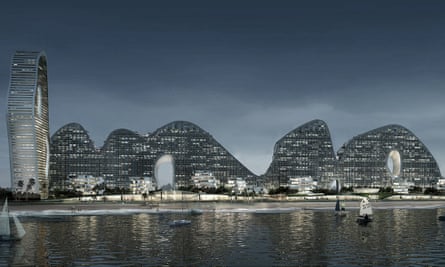
Forming an 800 metre-long cliff-face along the coast of the southern port city of Beihai, the Fake Hills housing block is the work of Ma Yansong, China’s homegrown conjuror of sinuous, globular forms – whose practice is appropriately named MAD. Having studied at Yale and worked with Zaha Hadid in London, where he nourished his penchant for blobs, Ma has spent the last decade dreaming up improbable mountain-shaped megastructures across the country.

As it rises and falls, the undulating roofline of Fake Hills forms terraces for badminton and tennis courts, as well as a garden and swimming pool. Sadly the overall effect is less scenic mountain range than a lumpen collision of colossal cruise-liners.
Greenland Tower, Chengdu
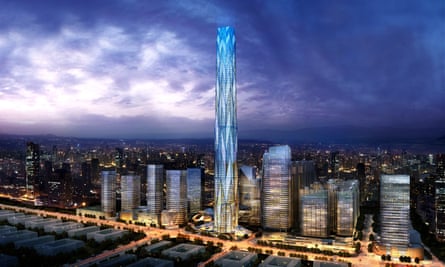
A crystalline spire rising 468 metres above the 18 million-strong metropolis of Chengdu, the Greenland Tower will be the tallest building in southwestern China, standing as a sharply chiselled monument to the country’s (and by some counts the world’s) largest property developer, Greenland Holdings. It is designed by Chicago-based Adrian Smith and Gordon Gill, architects of Dubai’s Burj Khalifa, who say the faceted shaft is a reference to the “unique ice mountain topography” of the region. It harks back to the crystalline dreams of early 20th-century German architect Bruno Taut, who imagined a dazzling glass “city crown” to celebrate socialism and agriculture; whether Sichuan’s farmers will be welcomed into the penthouse sky garden remains to be seen.
Sun-Moon mansion, Dezhou
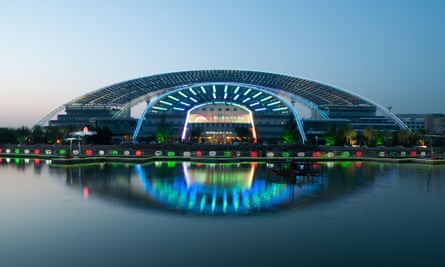
Once known as a centre of braised chicken production, the city of Dezhou in the north-eastern province of Shandong now brands itself as “Solar Valley”, a renewable energy centre intended to rival California’s Silicon Valley. At its heart is the Sun-Moon mansion, a vast fan-shaped office building powered by an arc of solar panels on its roof. It is the brainchild of Huang Ming, aka China’s “sun king”, an oil industry engineer turned solar energy tycoon who heads the Himin Solar Energy Group, the world’s biggest producer of solar water heaters – as well as purveyor of sun-warmed toilet seats and solar-powered Tibetan prayer wheels.
Harbin Opera House
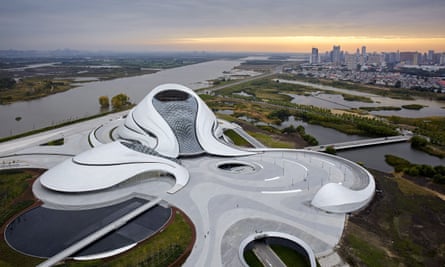
Nicknamed the St Petersburg of the east, the far northern city of Harbin has long had a thriving cultural scene as a gateway to Russia and beyond. In the 1920s, fashions from Paris and Moscow arrived here before they reached Shanghai, and it was home to the country’s first symphony orchestra, made up of mostly Russian musicians.
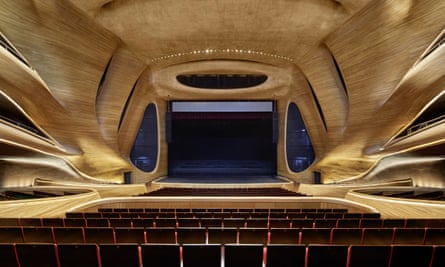
Declared “city of music” in 2010, Harbin has recently pumped millions into a gleaming new concert hall by Arata Isozaki, a gargantuan neo-classical conservatory and an 80,000 sq metre whipped meringue of an opera house by MAD. Shaped like a pair of snowy dunes, up which visitors can climb on snaking paths, the building contains a sinuous timber-lined auditorium designed as an eroded block of wood.
Tianjin Binhai library

Due to open this summer in the sprawling port city of Tianjin, this space-age library by Dutch architects MVRDV is imagined as a gaping cave of books, carved out from within an oblong glass block. The shelves form a terraced landscape of seating, wrapping around a giant mirrored sphere auditorium that nestles in the middle of the space like a pearl in an oyster.

Along with a new theatre, congress centre and a science and technology museum by Bernard Tschumi, the building forms part of a new cultural quarter for the city, itself being swallowed into the planned Beijing-Tianjin mega-region – population 130 million, that’s more than Japan.
Huaguoyuan Towers, Guiyang
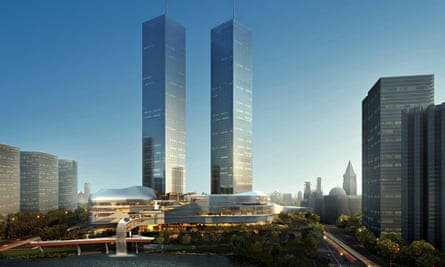
Nowhere in China is the disparity between economic reality and architectural ambition more stark than in Guiyang, capital of rural Guizhou, the poorest province in the country, which has the fifth most skyscraper plans of any Chinese city. The twin 335-metre towers of the Huaguoyuan development, by Arup, are now almost complete, standing as the centrepiece of a new mixed-use office, retail and entertainment complex, while SOM is busy conjuring the even higher Cultural Plaza Tower, a 521-metre glass spear that will soar above a new riverfront world of shopping malls and theatres. It has the glitz and gloss of any other Chinese city’s new central business district, but as Knight Frank’s David Ji points out: “It will be hard for a city like Guiyang to find quality tenants to fill the space.”
Yubei agricultural park, Chongqing
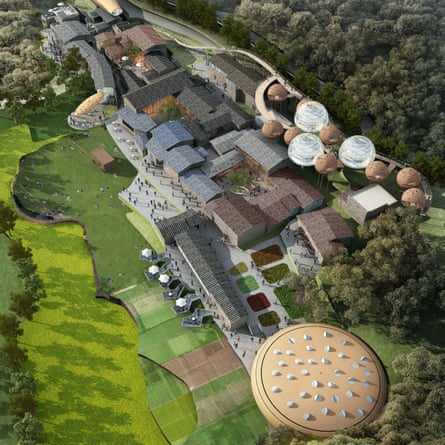
Architectural funster Will Alsop may finally have found his calling in the supercharged furnace of China’s second-tier cities’ booming leisure economy, crafting a number of fantastical dreamworlds from his new satellite studio in Chongqing – where he is busy building a new cultural quarter around his own office, with a restaurant, bar and distillery. He is also plotting an enormous agricultural leisure park in Yubei, 20 miles north of the city, designed to cater to the new middle classes’ nascent appreciation of the countryside, a place hitherto associated with peasants and poverty. The rolling landscape will be dotted with cocoon-like treehouses, a flower-shaped hotel and a big lake covered by an LED-screen canopy, so visitors can enjoy projected blue skies despite the smog.
Zendai Himalayas centre, Nanjing

Erupting across six city blocks like a limestone mountain range, the Zendai Himalayas Centre will be Ma’s most literal interpretation yet of his philosophy of fusing architecture and nature. Taking inspiration from the traditional style of “shanshui” landscape brush painting (literally meaning “mountain-water”), the 560,000 sq metre complex is designed to look as if it has been eroded by millennia of wind and water, not thrown up overnight by an army of migrant labourers. Once again, Ma appears to be forgetting that elegant feathery brushstrokes don’t often translate well into lumps of glass and steel. It is one of many such green-fingered schemes in Nanjing, including Stefano Boeri’s “vertical forest” towers and the Sifang art park, where Steven Holl, SANAA, David Adjaye and others have built pavilions in a rolling landscape – as another decoy for a luxury real estate project.
Huawei campus, Dongguan
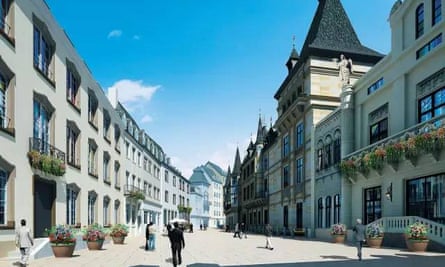
Telecoms giant Huawei has courted lawsuits for copying from rivals in the past, but its love of imitating clearly extends to architecture too. The company’s new campus, under construction on a 300-acre site in Dongguan, is based on 12 European towns. There are the dreaming spires of Oxford, the quaint redbrick houses of Bruges, the palazzos of Verona and the chateaux of Burgundy, all connected by a meandering Swiss railway. It might look like a theme park, but the employees will have little time for leisure: Huawei’s founder likens his staff to a pack of hungry wolves and offers them a “dedicated employee agreement” to voluntarily forgo paid holiday and overtime.
Guardian Cities is dedicating a week to the huge but often unreported cities on the front line of China’s unprecedented urbanisation. Explore our coverage here and follow us on Facebook. Share stories via WeChat (GuardianCities) and by using #OtherChina on Twitter and Instagram

Comments (…)
Sign in or create your Guardian account to join the discussion